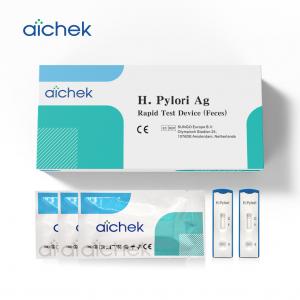
Add to Cart
| Product Name |
Infection Disease H.Pylori antigen Rapid Test |
| Formats | Strip(3mm)Device(4mm) |
| Place of Origen | China |
| Specimen | Feces |
| Read Time | 15 minutes |
| Shelf life | 2 years |
| Package | 25 device/box or 50 strip/Box |
| Storage | 2℃-30℃ |
For professional in vitro diagnostic use only.
INTENDED USE
The H. Pylori Ag Rapid Test Device (Feces) is a rapid chromatographic immunoassay for the qualitative detection of antigens to H. Pylori in feces to aid in the diagnosis of H. Pylori infection.
INTRODUCTION
The H. Pylori Ag Rapid Test Device (Feces) is a screening immunochromatographic assay to detect Helicobacter Pylori antigen in stool samples.
Helicobacter Pylori (also known as Campylobacter Pylori) is a spiral-shaped with a typical flagellum, Gram negative bacteria, infecting gastric mucosa. It causes several gastro-enteric diseases such as non-ulcerous dyspepsia, gastric and duodenal ulcer, active gastritis and can even increase the risk of stomach adenocarcinoma, so as to be classified as carcinogen agent type I.
Many H. Pylori strains have been isolated: among them, the strain expressing CagA antigen is strongly immunogenic and, according to this, it is of utmost clinical importance because it is associated to the cytotoxic factor. It is widely reported in many literature articles that, in infected patients showing antibodies against CagA gene product, the risk of gastric cancer is up to five times higher than the reference group infected with a CagA negative bacterial strain.
The presence of the gene itself determines the persistence of the infection, the ulceration and the protein associated, VacA toxin is frequently the main cause of infiltrations in the gastric mucosa.
This antigen associated to others, such as CagII, CagC, seems to act as starting agent of a sudden inflammatory response which can provoke ulceration (peptic ulcer), allergic episodes, and a decrease of the therapy efficacy.
At present several invasive and non-invasive approaches are available to detect this infection state.
Invasive methodologies requires endoscopy of the gastric mucosa with a histologic, cultural and urease investigation, which are cost-effective and requiring long times to come to a correct final diagnosis.
Alternatively, non-invasive methods are available such as Breath Test, which is extremely complicated and not highly selective, or classical ELISA and immunoblotting assays.
PERFORMANCE CHARACTERISTICS
Table: H. Pylori Ag Rapid Test vs. Biopsy/Histology/RUT
|
Relative Sensitivity: >95.0% (90.0%-97.9%)* Relative Specificity: >95.7% (92.3%-97.9%)* Overall Agreement: >95.4% (92.8%-97.3%)* *95% Confidence Interval |
H. Pylori Ag Rapid Test | ||||
| + | - | Total | |||
|
Biopsy/ Histology/ RUT |
+ | 131 | 7 | 138 | |
| - | 10 | 225 | 235 | ||
| 141 | 232 | 373 | |||